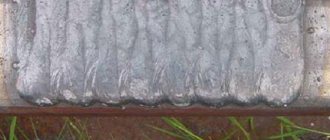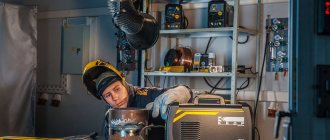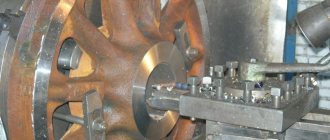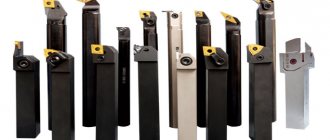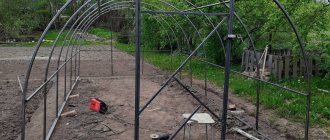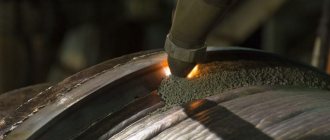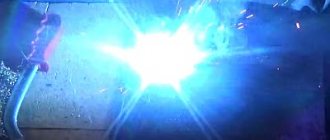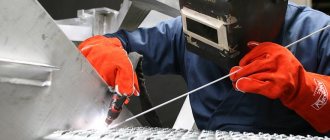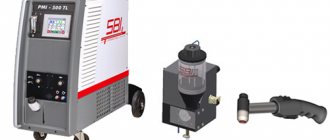What is metal surfacing
This is a procedure that is used to restore the shape and material of worn-out products and mechanisms. Using surfacing technology, it is possible to create a strengthening layer of metal on the surface and bimetallic structures.
Deposition is a type of welding technology. It is based on the same principles as classical welding. To process and protect the surfaces of products, various types of surfacing are used, which differ from each other in the methods of deposition and the composition of the welding medium.
Using this technology, you can work with structures of various compositions: copper, bronze, cast iron, as well as alloys (nickel, chrome, cobalt).
Surfacing of copper and its alloys (bronze)
Products made from technically pure copper are deposited using Komsomolets-100 electrodes or filler rods, the composition of which is close to the composition of the base metal. It is recommended to use preheating to 300-500°C. If the copper temperature exceeds 500°C, then the deposited layer must be forged.
If it is necessary to surfacing bronzes, it is better to use OZB-2M electrodes. The deposited metal has high surface wear resistance.
Surfacing of copper and its alloys is carried out using direct current of reverse polarity exclusively in the lower spatial position.
The brands of electrodes intended for welding copper and its alloys can be found in the corresponding section.
Features of surfacing technology
The advantages of surfacing are that it allows you to obtain reliable adhesion of the metal to the base, as well as the necessary physical and technological parameters. The first is achieved through high-quality preparation of the product, and the second through the correct selection of materials for the work.
The essence of surfacing is that it is necessary to uniformly apply narrow strips of molten metal to the surface so that they join into a continuous thick layer, ranging in size from a tenth of a millimeter to ten millimeters.
Surfacing of aluminum and its alloys
OZA-1 electrodes.
The most effective restoration method is arc surfacing. Electrodes of the OZA, OZANA and UANA brands are intended for products and structures made of aluminum and its alloys.
Consumables OZA-1 ensures the production of metal with high corrosion resistance.
The special coating of OZANA-1 electrodes allows you to normalize the process and destroy the oxide coating formed on aluminum products during work.
To regulate the structural composition of the deposited metal, powder electrodes should be used. Electrodes of this type make it possible to create not only a deposited layer of equal strength to the base metal, but also a layer with significantly improved characteristics.
A complete list of electrodes for welding aluminum and its alloys is presented in the corresponding section.
Types of surfacing
The surfacing technology must ensure the quality of the deposited layer and minimal impact on the metal to avoid its deformation. Different types of procedures have different processing methods and material consumption. Let's consider the main types of metal surfacing on parts.
1. Gear teeth.
A gear is a part of many mechanisms and machines used in various fields. The most common defects of this part are: wear along the length and thickness, the formation of cracks or scratches, chipping, and broken teeth.
The most effective method of restoration is metal surfacing. It is performed in several stages:
- First you need to cut out the parts with defects.
- Then you need to drill several holes and make a thread in the gap.
- Make pins and insert them into the seats.
- Make a deposition using electric welding and form a tooth from the metal.
The teeth can be repaired using an additive in the form of flux-cored wire, automatically. Before use, the product must be cleaned of dirt.
2. Ends of rails.
High-speed trains need high-quality rail tracks. Shocks or improper use will cause deformation, bending and dents. The rails can be returned to their original position using fusion.
To begin, take the broken rail and remove all the exfoliated and flattened material from it using sandpaper or a chisel. Then the ends of the rails are heated. For this purpose, various surfacing methods are used:
- Manual arc. It is performed by placing rollers on the rails lengthwise, diagonally or crosswise. Or the second option is to use fusing of a bundle of electrodes.
- Semi-automatic electric arc. It involves the use of self-shielding flux-cored wire. This method is characterized by high quality and productivity.
3. Planes and cylinders.
To restore products, the following surfacing methods are used:
- Coated electrodes. This method involves the use of rollers along closed circles or a helical line. The first option is suitable for long products of small diameter. The second involves turning the product over during operation. The third is convenient in the case of mechanized surfacing and uniform rotation of the part.
- Automatic submerged surfacing. The result is a wear-resistant layer. The method is carried out using welding or flux-cored wire. Deposition occurs along a helical or generatrix line.
Planes are simple surfaces of large area. They are restored using narrow rollers by soldering in several layers or by placing them so that they overlap 30-40% of the width of the previous one.
4. Stamps and metal-cutting tools.
Restoration of products is carried out in three ways: manual, automatic or semi-automatic arc surfacing. In the first case, electrodes are used. In the second and third - paste, flux and alloyed wire.
5. Stainless steel.
In this case, rods made of high-alloy wire are used. They allow you to obtain a joint that is resistant to rust and does not scuff. The method requires preheating the part and subsequent heat treatment.
6. Cast iron and its alloys.
Electrodes of various brands are used for surfacing cast iron and its alloys. Some of them are universal and suitable for all types of alloys.
7. Copper and its alloys.
Deposition of pure copper products is carried out using Komsomolets-100 electrodes or filler rods. The products are preheated to a temperature of 300 to 500 degrees. If the temperature reaches more than 500 degrees, then the deposited layer is subjected to forging. Surfacing is carried out using direct current. The result is a material with increased wear resistance.
Surfacing of metal-cutting tools and dies
Restoration of metal-cutting tools and dies is performed by arc surfacing in three ways: manual, automatic and semi-automatic.
The first option involves the use of electrodes. Metal-cutting tools and dies operate during cold and hot stamping, so they should be restored using the following grades of electrodes: OZI-3; OZI-5; OZI-6; TsS-1; CI-1M. The layer deposited with such materials has a high level of resistance to abrasion and crushing under heavy loads and high temperatures (up to 650-850°C). The product must be heated to 300-700°C before fusing. Fusing is carried out in 1-3 layers, the thickness is 2-6 mm.
We invite you to watch a video demonstration of the Zeller 769 electrode surfacing test.
Automatic and semi-automatic methods are carried out with alloyed wire using fluxes or pastes.
Metal surfacing methods
The surfacing method should be as simple, fast and safe as possible to implement, and also prevent metal deformation. Let's look at the main methods, the most common.
1. Electric arc.
For it, classic electric arc equipment is most often used. It can be manual or mechanized. The first option involves the use of conventional DC inverters and rectifiers, in which the plus is connected to the electrode, and the minus to the product itself. This simple assembly reduces the level of overall heating and melts the base layer shallowly. If you add a special additive mixture, you can evenly increase the surface strength.
Mechanized surfacing is carried out using semi-automatic welding machines with solid or flux-cored wire. The main advantages of this method are a high level of productivity and joint quality. If you first sand and clean the area, the seam will be perfectly smooth.
2. Vibro-arc.
This method is used to work with non-ferrous metals up to 1 mm thick and with virtually no heating of the top layer of the product. During the procedure, the electrode moves with an amplitude of 0.3-3 mm and a frequency of up to 100 Hz. As a result, an arc is created for one-fifth of the total time and a small amount of metal is exposed to the surface. The depth and thermal impact on the part are minimal.
For vibratory arc surfacing, semi-automatic machines with special electromechanical devices with intermittent wire feed (1.6-2 mm) are used. The procedure must be carried out in a safe environment consisting of gas, solution or foam that is safe for health.
3. Gas flame.
This method is considered the simplest and most accessible. Acetylene or propane-butane mixture is used as a heat source; as an additive - rods or wire; for fluxes - a mixture of boric acid or borax.
Small parts are welded immediately, and large parts are first heated to a temperature of 500 degrees. Powders can be used as useful additives; they can be introduced into a flame stream, which can settle on the surface in small drops.
For gas-flame fusing, plasmatrons are required - special welding machines equipped with a powerful torch. Additives are supplied only in an automated manner, as this is unsafe for humans. Not only powders, but also granules can be used as additives.
The advantages of the method are shallow welding and a uniform structure of the joint layer. The disadvantage is the high cost of the method and heating the plasma to high temperatures.
4. Plasma.
It is performed on special devices equipped with a gas burner. A flow is formed in it, reaching a temperature of several tens of thousands of degrees. Powder or granular mixtures can also be used as additives.
5. Electroslag.
This thermal process uses a slag bath - a container with a catalyst, which moves along the workpiece. An electrode or additive in the form of a granular composition is placed in this vessel. Then the temperature is increased under flux and slag. In this case, the materials become a kind of protective shield that protects the work area from harmful gas effects.
The slag bath is located vertically: thus, air bubbles do not have time to form pores and do not float up. As a result, there is no heat loss or splashing. The advantage of this method is that it is an affordable option. But the disadvantage is labor intensity and the inability to work with small-sized parts and complex configurations.
6. Laser.
Flux or powder is used as an additive; they are melted using a focused laser beam. The laser is emitted from a special head using a nozzle (heats the gas flow) or an injector (injects a useful additive).
The method allows you to ensure the most accurate result and stable quality coating. The method is used only in very critical cases, as it is the most expensive to use.
7. Induction.
The principle of the method is to melt the filler material and the upper metal layer using vortex flows that are induced on the surface. To do this, a flux additive is applied to the product area. Then an inductor made of several turns of a tube with high-precision voltage is located above it.
The depth of deposition depends on the frequency of the inductor current: the higher it is, the lower the depth. This method is considered the most productive and provides minimal heating of the metal.
8. Electric spark.
The procedure is carried out using short-term current discharges and the application of an ultra-thin coating. Surfacing is carried out using a special installation. The electrode must be set to the plus sign, and the workpiece to the minus sign. When current discharges, the particles are torn out and welded into a dense, finely porous seam.
The method is considered affordable and convenient, due to the almost complete absence of surface heating. No oxidation or deformation is observed during the procedure. Thus, the product receives a long service life.
Mechanized arc surfacing methods
When choosing an arc surfacing method, it is necessary to take into account such important parameters as the characteristics of the material of the part intended for restoration, the physical and mechanical properties of the deposited coating, the geometric parameters of the workpiece, the level of wear and some others.
There are two types of mechanized welding (surfacing) - automatic and semi-automatic. In the first case, there is a mechanical supply of both electrode consumables (ribbons or wires) into the processing area, as well as relative movement of the part and the electrode. In the semi-automatic welding method, only the electrodes are moved mechanically. The electrode wire is supplied through a hose to the holder, which is moved by the welder himself along the required path manually.
To perform work using the automatic arc surfacing method, the following basic equipment is required: a welding head, a lathe or special machine, a power source and a hardware box.
The design of the welding head (automatic) consists of a feed mechanism for tape or electrode wire (traction rollers are most often used) with blocks for adjusting the speed of feed, lowering, raising, and turning the head.
Some models of surfacing installations, in addition to a device for supplying the electrode to the workpiece, are equipped with a mechanism that produces transverse vibrations of the electrode, which makes it possible to obtain a much wider deposited layer in one pass. This helps improve productivity and seam quality.
Equipment used
Surfacing equipment operates using the same heating sources and methods as welding equipment. It differs in that it has auxiliary devices that ensure the supply and distribution of additives over the surface of the product.
For surfacing, welding devices are often used, which can be supplemented with the necessary devices and equipment. Surfacing equipment is divided according to the shape of the working surfaces: for bodies of revolution, for flat parts, for complex profiles.
The additive is applied using classical methods (for example, spraying, rods, wire) or special ones (centrifugal distribution, spiral laying, etc.).
Surfacing equipment is equipped with devices for preheating the product (from 500 to 700 degrees). The market offers small-sized units for home use that work with metals up to several millimeters thick.
Surfacing of cast iron and its alloys
The most popular brands of electrodes for surfacing cast iron are:
Electrodes TsCh 4.
OZCH-2 are designed for surfacing ductile and gray cast iron.
MNCh-2 electrodes ensure the density and cleanliness of the deposited layer (after processing).
OZZHN-1 and OZZHN-2 are used for working with gray and high-strength cast iron.
TsCh-4 electrodes have good welding and technological characteristics: ease of ignition and stability of the arc, low spatter.
Some grades are universal; they can be used to weld various types of cast iron: malleable, gray, etc. Most are intended for certain types of alloys. A complete list of electrodes for welding cast iron can be found in the corresponding section.
Consumption of materials
To determine the cost of the finished product, it is necessary to correctly calculate the consumption of materials used in the deposition process. Calculations are carried out in accordance with the standards adopted for each type of material. The exact quantity of consumables will allow you to create stocks of materials and ensure continuity of the process.
Calculation of metal during welding is the main indicator, which is determined using a special formula. The mass is calculated from the consumption of 1 meter of weld. Use the formula:
G = F * y * L, where:
F – cross-sectional area of the weld (in mm2);
y – specific mass of metal (g/cm3);
L – the length of the weld is 1 meter.
The master will be able to independently calculate the mass of metal deposited during the welding process.
Calculation of electrodes for surfacing is a significant quantitative parameter for which no calculations are required. Each grade of materials has its own indicator for 1 kg of surfacing. It varies from 1.4 kg to 1.8 kg.
There is no need to calculate the mass of the deposited weld. According to government standards, each weld shape has an average rating. In this case, the form must be made of low-alloy or carbon steel, and also be made using the manual electric arc method.
Surfacing of parts exposed to abrasion with impact loads and without impact loads
Products operating under conditions of intense surface wear and high shock loads must be overlaid with electrodes of the following brands:
Welding electrodes for surfacing OZN-400M
Advantages of OMG-N: they comply with state standards, deposition can be carried out with direct and alternating current of reverse polarity.
TsNIIN-4 is one of the most popular and popular brands.
Metal deposited with OZN-7M rods during multilayer deposition has increased resistance to cracking.
Advantages of OZN-400M: high productivity, deposited metal is characterized by increased hardness.
Advantages of OZN-300M: the deposited metal has increased stability of wear resistance and hardness; surfacing is performed with direct and alternating current of reverse polarity.
An example of such parts is elements of construction and earth-moving equipment.
For surfacing parts exposed to abrasion and without shock loads, the following grades of electrodes are used.
To obtain a deposited layer of special hardness, it is necessary to use surfacing electrodes T-590 and T-620. These brands are intended for repairing parts subject to intense abrasion. Thanks to a special coating, which includes ferrochrome, ferrotitanium, ferroboron, boron carbide and graphite, the hardness of the deposited metal can reach 62-64 HRC. Metal deposited with T-590 and T-620 materials is brittle and prone to cracking, and is therefore not intended to withstand significant shock loads. Fusing is carried out in 1-2 layers.
Repair of products made of various metals and alloys also has its own specific characteristics.
